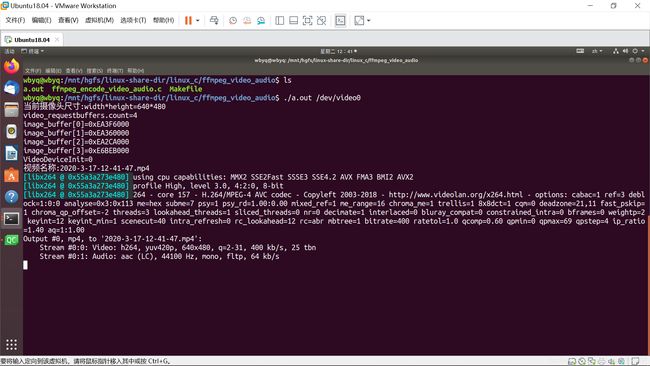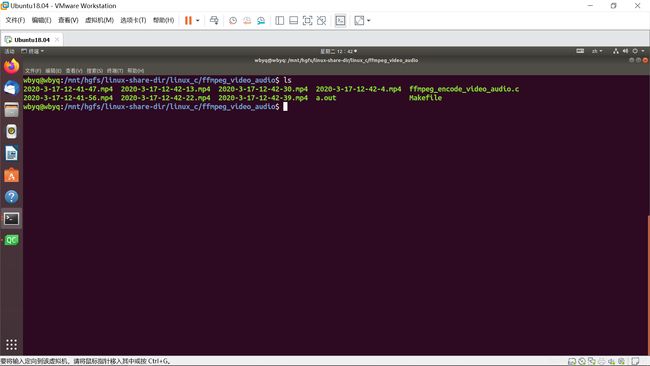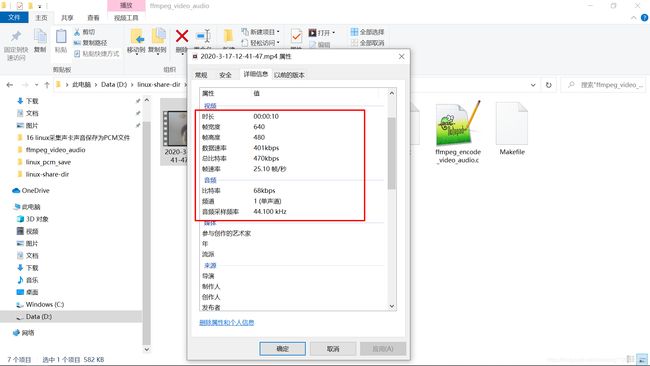FFMPEG音频开发: Linux下采集摄像头(使用V4L2框架)数据录制成MP4视频保存到本地
一、环境介绍
操作系统介绍:ubuntu 18.04
FFMPEG版本: 4.4.2
摄像头: USB摄像头、虚拟机挂载本机自带摄像头
二、FFMPEG与X264下载编译
X264下载地址: http://www.videolan.org/developers/x264.html
FFMPEG下载地址: https://ffmpeg.org/download.html
Yasm 库的官网下载地址: http://yasm.tortall.net/Download.html
在 PC 机 Linux 编译 X264 需要 yasm 库支持。
编译yasm库:
./configure
make
make install编译X264库:
./configure --prefix=$PWD/_install --enable-shared --enable-static
make install编译FFMPEG库:(需要依赖X264库,自行修改路径)
./configure --enable-static --enable-shared --prefix=$PWD/
_install --extra-cflags=-I/home/wbyq/pc_work/x264-snapshot-20160527-2245/_install/includ
e --extra-ldflags=-L/home/wbyq/pc_work/x264-snapshot-20160527-2245/_install/lib --enable
-ffmpeg --enable-libx264 --enable-gpl三、程序功能介绍
说明: 下面程序参考FFMPEG提供的例子程序muxing.c进行修改。
功能介绍: 程序里目前有一个子线程和一个主线程,子线程通过linux标准的V4L2框架读取摄像头数据(YUYV)转换为YUV420P格式(H264必须使用该格式编码),主线程里进行视频和音频编码。目前程序里还没有加入实时音频采集功能,音频直接使用的例子代码里生成的固定声音。
linux下音频采集的文章: https://blog.csdn.net/xiaolong1126626497/article/details/104916277
为了方便贴代码,工程的代码全部在一个.c里,没有使用多文件存放。
程序运行流程介绍: 每次采集10秒的摄像头视频保存到本地,循环采集,视频的名称使用当前系统的时间命名,视频格式是MP4格式。
四、源代码
#include
#include
#include
#include
#include
#include
#include
#include
#include
#include
#include
#include
#include
#include
#include
#include
#include
#include
#include
#include
#include
#include
#include
#include
#include
#include
#include
#include
#include
#include
#include
#define STREAM_DURATION 10.0 /*录制10秒的视频,由于缓冲的原因,一般只有8秒*/
#define STREAM_FRAME_RATE 25 /* 25 images/s avfilter_get_by_name */
#define STREAM_PIX_FMT AV_PIX_FMT_YUV420P /* default pix_fmt */
#define SCALE_FLAGS SWS_BICUBIC
//固定摄像头输出画面的尺寸
#define VIDEO_WIDTH 640
#define VIDEO_HEIGHT 480
//存放从摄像头读出转换之后的数据
unsigned char YUV420P_Buffer[VIDEO_WIDTH*VIDEO_HEIGHT*3/2];
unsigned char YUV420P_Buffer_temp[VIDEO_WIDTH*VIDEO_HEIGHT*3/2];
/*一些摄像头需要使用的全局变量*/
unsigned char *image_buffer[4];
int video_fd;
pthread_mutex_t mutex;
pthread_cond_t cond;
// 单个输出AVStream的包装器
typedef struct OutputStream {
AVStream *st;
AVCodecContext *enc;
/* 下一帧的点数*/
int64_t next_pts;
int samples_count;
AVFrame *frame;
AVFrame *tmp_frame;
float t, tincr, tincr2;
struct SwsContext *sws_ctx;
struct SwrContext *swr_ctx;
} OutputStream;
static int write_frame(AVFormatContext *fmt_ctx, const AVRational *time_base, AVStream *st, AVPacket *pkt)
{
/*将输出数据包时间戳值从编解码器重新调整为流时基 */
av_packet_rescale_ts(pkt, *time_base, st->time_base);
pkt->stream_index = st->index;
/*将压缩的帧写入媒体文件*/
return av_interleaved_write_frame(fmt_ctx, pkt);
}
/* 添加输出流。 */
static void add_stream(OutputStream *ost, AVFormatContext *oc,
AVCodec **codec,
enum AVCodecID codec_id)
{
AVCodecContext *c;
int i;
/* find the encoder */
*codec = avcodec_find_encoder(codec_id);
if (!(*codec)) {
fprintf(stderr, "Could not find encoder for '%s'\n",
avcodec_get_name(codec_id));
exit(1);
}
ost->st = avformat_new_stream(oc, NULL);
if (!ost->st) {
fprintf(stderr, "Could not allocate stream\n");
exit(1);
}
ost->st->id = oc->nb_streams-1;
c = avcodec_alloc_context3(*codec);
if (!c) {
fprintf(stderr, "Could not alloc an encoding context\n");
exit(1);
}
ost->enc = c;
switch ((*codec)->type) {
case AVMEDIA_TYPE_AUDIO:
c->sample_fmt = (*codec)->sample_fmts ? (*codec)->sample_fmts[0] : AV_SAMPLE_FMT_FLTP;
c->bit_rate = 64000; //设置码率
c->sample_rate = 44100; //音频采样率
c->channels= av_get_channel_layout_nb_channels(c->channel_layout);
c->channel_layout = AV_CH_LAYOUT_MONO; AV_CH_LAYOUT_MONO 单声道 AV_CH_LAYOUT_STEREO 立体声
c->channels = av_get_channel_layout_nb_channels(c->channel_layout);
ost->st->time_base = (AVRational){ 1, c->sample_rate };
break;
case AVMEDIA_TYPE_VIDEO:
c->codec_id = codec_id;
//码率:影响体积,与体积成正比:码率越大,体积越大;码率越小,体积越小。
c->bit_rate = 400000; //设置码率 400kps
/*分辨率必须是2的倍数。 */
c->width =VIDEO_WIDTH;
c->height = VIDEO_HEIGHT;
/*时基:这是基本的时间单位(以秒为单位)
*表示其中的帧时间戳。 对于固定fps内容,
*时基应为1 / framerate,时间戳增量应为
*等于1。*/
ost->st->time_base = (AVRational){1,STREAM_FRAME_RATE};
c->time_base = ost->st->time_base;
c->gop_size = 12; /* 最多每十二帧发射一帧内帧 */
c->pix_fmt = STREAM_PIX_FMT;
c->max_b_frames = 0; //不要B帧
if (c->codec_id == AV_CODEC_ID_MPEG1VIDEO)
{
c->mb_decision = 2;
}
break;
default:
break;
}
/* 某些格式希望流头分开。 */
if (oc->oformat->flags & AVFMT_GLOBALHEADER)
c->flags |= AV_CODEC_FLAG_GLOBAL_HEADER;
}
/**************************************************************/
/* audio output */
static AVFrame *alloc_audio_frame(enum AVSampleFormat sample_fmt,
uint64_t channel_layout,
int sample_rate, int nb_samples)
{
AVFrame *frame = av_frame_alloc();
frame->format = sample_fmt;
frame->channel_layout = channel_layout;
frame->sample_rate = sample_rate;
frame->nb_samples = nb_samples;
if(nb_samples)
{
av_frame_get_buffer(frame, 0);
}
return frame;
}
static void open_audio(AVFormatContext *oc, AVCodec *codec, OutputStream *ost, AVDictionary *opt_arg)
{
AVCodecContext *c;
int nb_samples;
int ret;
AVDictionary *opt = NULL;
c = ost->enc;
av_dict_copy(&opt, opt_arg, 0);
ret = avcodec_open2(c, codec, &opt);
av_dict_free(&opt);
/*下面3行代码是为了生成虚拟的声音设置的频率参数*/
ost->t = 0;
ost->tincr = 2 * M_PI * 110.0 / c->sample_rate;
ost->tincr2 = 2 * M_PI * 110.0 / c->sample_rate / c->sample_rate;
//AAC编码这里就固定为1024
nb_samples = c->frame_size;
ost->frame = alloc_audio_frame(c->sample_fmt, c->channel_layout,
c->sample_rate, nb_samples);
ost->tmp_frame = alloc_audio_frame(AV_SAMPLE_FMT_S16, c->channel_layout,
c->sample_rate, nb_samples);
/* copy the stream parameters to the muxer */
avcodec_parameters_from_context(ost->st->codecpar, c);
/* create resampler context */
ost->swr_ctx = swr_alloc();
/* set options */
av_opt_set_int (ost->swr_ctx, "in_channel_count", c->channels, 0);
av_opt_set_int (ost->swr_ctx, "in_sample_rate", c->sample_rate, 0);
av_opt_set_sample_fmt(ost->swr_ctx, "in_sample_fmt", AV_SAMPLE_FMT_S16, 0);
av_opt_set_int (ost->swr_ctx, "out_channel_count", c->channels, 0);
av_opt_set_int (ost->swr_ctx, "out_sample_rate", c->sample_rate, 0);
av_opt_set_sample_fmt(ost->swr_ctx, "out_sample_fmt", c->sample_fmt, 0);
/* initialize the resampling context */
swr_init(ost->swr_ctx);
}
/*
准备虚拟音频帧
这里可以替换成从声卡读取的PCM数据
*/
static AVFrame *get_audio_frame(OutputStream *ost)
{
AVFrame *frame = ost->tmp_frame;
int j, i, v;
int16_t *q = (int16_t*)frame->data[0];
/* 检查我们是否要生成更多帧,用于判断是否结束*/
if (av_compare_ts(ost->next_pts, ost->enc->time_base,STREAM_DURATION, (AVRational){ 1, 1 }) >= 0)
return NULL;
for(j = 0; jnb_samples; j++) //nb_samples: 此帧描述的音频样本数(每个通道)
{
v=(int)(sin(ost->t) * 1000);
for(i=0;ienc->channels;i++) //channels:音频通道数
{
*q++ = v; //音频数据
}
ost->t += ost->tincr;
ost->tincr += ost->tincr2;
}
frame->pts = ost->next_pts;
ost->next_pts += frame->nb_samples;
return frame;
}
/*
*编码一个音频帧并将其发送到多路复用器
*编码完成后返回1,否则返回0
*/
static int write_audio_frame(AVFormatContext *oc, OutputStream *ost)
{
AVCodecContext *c;
AVPacket pkt = { 0 };
AVFrame *frame;
int ret;
int got_packet;
int dst_nb_samples;
av_init_packet(&pkt);
c = ost->enc;
frame = get_audio_frame(ost);
if(frame)
{
/*使用重采样器将样本从本机格式转换为目标编解码器格式*/
/*计算样本的目标数量*/
dst_nb_samples = av_rescale_rnd(swr_get_delay(ost->swr_ctx, c->sample_rate) + frame->nb_samples,
c->sample_rate, c->sample_rate, AV_ROUND_UP);
av_assert0(dst_nb_samples == frame->nb_samples);
av_frame_make_writable(ost->frame);
/*转换为目标格式 */
swr_convert(ost->swr_ctx,
ost->frame->data, dst_nb_samples,
(const uint8_t **)frame->data, frame->nb_samples);
frame = ost->frame;
frame->pts = av_rescale_q(ost->samples_count, (AVRational){1, c->sample_rate}, c->time_base);
ost->samples_count += dst_nb_samples;
}
avcodec_encode_audio2(c, &pkt, frame, &got_packet);
if (got_packet)
{
write_frame(oc, &c->time_base, ost->st, &pkt);
}
return (frame || got_packet) ? 0 : 1;
}
static AVFrame *alloc_picture(enum AVPixelFormat pix_fmt, int width, int height)
{
AVFrame *picture;
int ret;
picture = av_frame_alloc();
picture->format = pix_fmt;
picture->width = width;
picture->height = height;
/* allocate the buffers for the frame data */
av_frame_get_buffer(picture, 32);
return picture;
}
static void open_video(AVFormatContext *oc, AVCodec *codec, OutputStream *ost, AVDictionary *opt_arg)
{
AVCodecContext *c = ost->enc;
AVDictionary *opt = NULL;
av_dict_copy(&opt, opt_arg, 0);
/* open the codec */
avcodec_open2(c, codec, &opt);
av_dict_free(&opt);
/* allocate and init a re-usable frame */
ost->frame = alloc_picture(c->pix_fmt, c->width, c->height);
ost->tmp_frame = NULL;
/* 将流参数复制到多路复用器 */
avcodec_parameters_from_context(ost->st->codecpar, c);
}
/*
准备图像数据
YUV422占用内存空间 = w * h * 2
YUV420占用内存空间 = width*height*3/2
*/
static void fill_yuv_image(AVFrame *pict, int frame_index,int width, int height)
{
int y_size=width*height;
/*等待条件成立*/
pthread_cond_wait(&cond,&mutex);
memcpy(YUV420P_Buffer_temp,YUV420P_Buffer,sizeof(YUV420P_Buffer));
/*互斥锁解锁*/
pthread_mutex_unlock(&mutex);
//将YUV数据拷贝到缓冲区 y_size=wXh
memcpy(pict->data[0],YUV420P_Buffer_temp,y_size);
memcpy(pict->data[1],YUV420P_Buffer_temp+y_size,y_size/4);
memcpy(pict->data[2],YUV420P_Buffer_temp+y_size+y_size/4,y_size/4);
}
static AVFrame *get_video_frame(OutputStream *ost)
{
AVCodecContext *c = ost->enc;
/* 检查我们是否要生成更多帧---判断是否结束录制 */
if(av_compare_ts(ost->next_pts, c->time_base,STREAM_DURATION, (AVRational){ 1, 1 }) >= 0)
return NULL;
/*当我们将帧传递给编码器时,它可能会保留对它的引用
*内部; 确保我们在这里不覆盖它*/
if (av_frame_make_writable(ost->frame) < 0)
exit(1);
//制作虚拟图像
//DTS(解码时间戳)和PTS(显示时间戳)
fill_yuv_image(ost->frame, ost->next_pts, c->width, c->height);
ost->frame->pts = ost->next_pts++;
return ost->frame;
}
/*
*编码一个视频帧并将其发送到多路复用器
*编码完成后返回1,否则返回0
*/
static int write_video_frame(AVFormatContext *oc, OutputStream *ost)
{
int ret;
AVCodecContext *c;
AVFrame *frame;
int got_packet = 0;
AVPacket pkt = { 0 };
c=ost->enc;
//获取一帧数据
frame = get_video_frame(ost);
av_init_packet(&pkt);
/* 编码图像 */
ret=avcodec_encode_video2(c, &pkt, frame, &got_packet);
if(got_packet)
{
ret=write_frame(oc, &c->time_base, ost->st, &pkt);
}
else
{
ret = 0;
}
return (frame || got_packet) ? 0 : 1;
}
static void close_stream(AVFormatContext *oc, OutputStream *ost)
{
avcodec_free_context(&ost->enc);
av_frame_free(&ost->frame);
av_frame_free(&ost->tmp_frame);
sws_freeContext(ost->sws_ctx);
swr_free(&ost->swr_ctx);
}
//编码视频和音频
int video_audio_encode(char *filename)
{
OutputStream video_st = { 0 }, audio_st = { 0 };
AVOutputFormat *fmt;
AVFormatContext *oc;
AVCodec *audio_codec, *video_codec;
int ret;
int have_video = 0, have_audio = 0;
int encode_video = 0, encode_audio = 0;
AVDictionary *opt = NULL;
int i;
/* 分配输出环境 */
avformat_alloc_output_context2(&oc,NULL,NULL,filename);
fmt=oc->oformat;
/*使用默认格式的编解码器添加音频和视频流,初始化编解码器。 */
if(fmt->video_codec != AV_CODEC_ID_NONE)
{
add_stream(&video_st,oc,&video_codec,fmt->video_codec);
have_video = 1;
encode_video = 1;
}
if(fmt->audio_codec != AV_CODEC_ID_NONE)
{
add_stream(&audio_st, oc, &audio_codec, fmt->audio_codec);
have_audio = 1;
encode_audio = 1;
}
/*现在已经设置了所有参数,可以打开音频视频编解码器,并分配必要的编码缓冲区。 */
if (have_video)
open_video(oc, video_codec, &video_st, opt);
if (have_audio)
open_audio(oc, audio_codec, &audio_st, opt);
av_dump_format(oc, 0, filename, 1);
/* 打开输出文件(如果需要) */
if(!(fmt->flags & AVFMT_NOFILE))
{
ret = avio_open(&oc->pb, filename, AVIO_FLAG_WRITE);
if (ret < 0)
{
fprintf(stderr, "无法打开输出文件: '%s': %s\n", filename,av_err2str(ret));
return 1;
}
}
/* 编写流头(如果有)*/
avformat_write_header(oc,&opt);
while(encode_video || encode_audio)
{
/* 选择要编码的流*/
if(encode_video &&(!encode_audio || av_compare_ts(video_st.next_pts, video_st.enc->time_base,audio_st.next_pts, audio_st.enc->time_base) <= 0))
{
encode_video = !write_video_frame(oc,&video_st);
}
else
{
encode_audio = !write_audio_frame(oc,&audio_st);
}
}
av_write_trailer(oc);
if (have_video)
close_stream(oc, &video_st);
if (have_audio)
close_stream(oc, &audio_st);
if (!(fmt->flags & AVFMT_NOFILE))
avio_closep(&oc->pb);
avformat_free_context(oc);
return 0;
}
/*
函数功能: 摄像头设备初始化
*/
int VideoDeviceInit(char *DEVICE_NAME)
{
/*1. 打开摄像头设备*/
video_fd=open(DEVICE_NAME,O_RDWR);
if(video_fd<0)return -1;
/*2. 设置摄像头支持的颜色格式和输出的图像尺寸*/
struct v4l2_format video_formt;
memset(&video_formt,0,sizeof(struct v4l2_format));
video_formt.type=V4L2_BUF_TYPE_VIDEO_CAPTURE; /*视频捕获设备*/
video_formt.fmt.pix.height=VIDEO_HEIGHT; //480
video_formt.fmt.pix.width=VIDEO_WIDTH; //640
video_formt.fmt.pix.pixelformat=V4L2_PIX_FMT_YUYV;
if(ioctl(video_fd,VIDIOC_S_FMT,&video_formt))return -2;
printf("当前摄像头尺寸:width*height=%d*%d\n",video_formt.fmt.pix.width,video_formt.fmt.pix.height);
/*3.请求申请缓冲区的数量*/
struct v4l2_requestbuffers video_requestbuffers;
memset(&video_requestbuffers,0,sizeof(struct v4l2_requestbuffers));
video_requestbuffers.count=4;
video_requestbuffers.type=V4L2_BUF_TYPE_VIDEO_CAPTURE; /*视频捕获设备*/
video_requestbuffers.memory=V4L2_MEMORY_MMAP;
if(ioctl(video_fd,VIDIOC_REQBUFS,&video_requestbuffers))return -3;
printf("video_requestbuffers.count=%d\n",video_requestbuffers.count);
/*4. 获取缓冲区的首地址*/
struct v4l2_buffer video_buffer;
memset(&video_buffer,0,sizeof(struct v4l2_buffer));
int i;
for(i=0;i\n");
return 0;
}
int err;
pthread_t thread_id;
/*初始化互斥锁*/
pthread_mutex_init(&mutex,NULL);
/*初始化条件变量*/
pthread_cond_init(&cond,NULL);
/*初始化摄像头设备*/
err=VideoDeviceInit(argv[1]);
printf("VideoDeviceInit=%d\n",err);
if(err!=0)return err;
/*创建子线程: 采集摄像头的数据*/
pthread_create(&thread_id,NULL,pthread_read_video_data,NULL);
/*设置线程的分离属性: 采集摄像头的数据*/
pthread_detach(thread_id);
char filename[100];
time_t t;
struct tm *tme;
//开始音频、视频编码
while(1)
{
//获取本地时间
t=time(NULL);
t=t+8*60*60; //+上8个小时
tme=gmtime(&t);
sprintf(filename,"%d-%d-%d-%d-%d-%d.mp4",tme->tm_year+1900,tme->tm_mon+1,tme->tm_mday,tme->tm_hour,tme->tm_min,tme->tm_sec);
printf("视频名称:%s\n",filename);
//开始视频编码
video_audio_encode(filename);
}
return 0;
}
编译程序的Makefile文件:
app:
gcc ffmpeg_encode_video_audio.c -I /home/wbyq/work_pc/ffmpeg-4.2.2/_install/include -L /home/wbyq/work_pc/ffmpeg-4.2.2/_install/lib -lavcodec -lavfilter -lavutil -lswresample -lavdevice -lavformat -lpostproc -lswscale -L/home/wbyq/work_pc/x264-snapshot-20181217-2245/_install/lib -lx264 -lm -lpthread程序运行示例:
wbyq@wbyq:/mnt/hgfs/linux-share-dir/linux_c/ffmpeg_video_audio$ ./a.out /dev/video0录制过程中:
保存的视频文件:
视频的信息:
下面公众号里有全套的、C、C++、单片机、QT基础学习教程:



